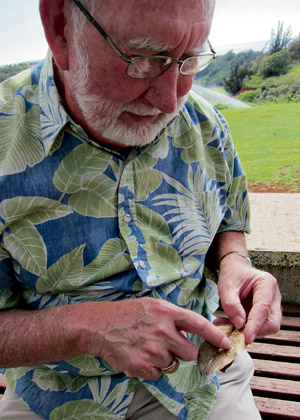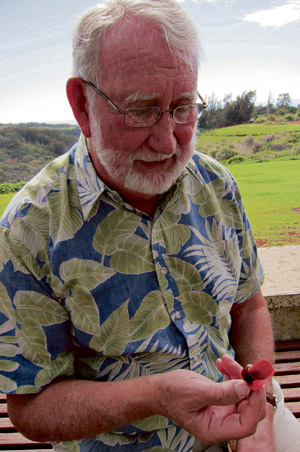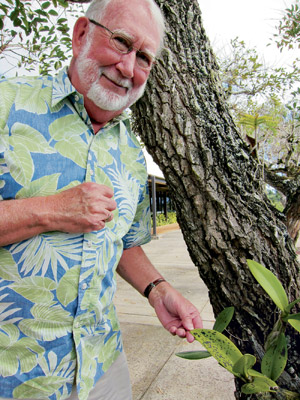The Plant Doctor Makes A Garden Call
 Having a problem in your garden? You’re not alone, and Bob Nyvall is offering help Sunday afternoons at NTBG’s Visitor Center in Poipu
Having a problem in your garden? You’re not alone, and Bob Nyvall is offering help Sunday afternoons at NTBG’s Visitor Center in Poipu
Hawaii may be a tropical paradise, but it’s also a hotbed for plant diseases.
“It’s like a Petri dish environment for pathogens to grow,” says plant pathologist Bob Nyvall.
The part-time Kaua‘i resident is voluntarily helping people prevent ailments like fungi and bacteria from infecting their plants from 2 to 4 p.m. every Sunday at National Tropical Botanical Garden’s Visitor Center in Po‘ipu until April 14.
Kama’aina are invited to bring samples of their flora to Nyvall, who will provide a professional assessment of what might be causing the plant distress and offer free advice on healing and preventing any infection from spreading.
“Your patients can’t talk to you. You have to be able to read the symptoms and signs, and come up with the answer or solution to what’s making them ill,” says the Minnesota native.
Though he doesn’t have the ability to assess a situation through laboratory analysis at the center, he is confident that he can at least help people identify and avoid future problems.
Approximately 75 percent of all plant diseases are initiated by fungi. Though they may not necessarily cause death, they can produce leaf spots or cause injuries. Excess moisture is an agent for its growth and also the spread of bacteria.
While bacteria need a wound or natural opening in a plant to affect it, fungi “just kind of blast their way in,” says Nyvall, who is obviously passionate about maintaining the health of plants.
Insect injury also can have a negative impact on plants.
“It’s also a favorable environment for them,” says Nyvall. “Pathogens and insects have a big ol’ smorgasbord to feast on.”
In addition, Hawaii is host to viruses and nematode diseases. Viruses infect plants much in the same way they do humans, and often are carried by the insects that feed on plants.
Nematodes also are abundant because of past agricultural practices – particularly pineapple production, which was prone to attracting the small, round worms. Soil from former plantation fields is still loaded with nematodes that can create a host of issues for plants.
Though conducting a full-fledged lab experiment would be the most precise way of identifying diseases, Nyvall’s more than 40 years of experience has led him to discern regularly repetitive symptoms.
The best way to deter most diseases, however, is by preventing them before they occur.
“The simplest thing is to grow resistant varieties,” he says.
Mulches and crop rotation are among the many other ways to stop diseases in their tracks.
Plant problems that persist on Kaua’i are largely the result of incorrect horticultural practices. For example, plants are placed in locations not conducive to their growth, fertilization does not occur regularly and watering is not done properly. Damage even can be caused by herbicides. Some poisons don’t work well with certain plants and can cause damage and injury.
“It’s mostly about really knowing what a plant needs,” he says.
Nyvall, who has a bach-elor’s, a master’s and a Ph.D. from the University of Minnesota, has had a love for plants for as long as he can remember. He also recalls what a great gardener his mother was.
“She had a love of plants and birds and the outdoors,” recalls Nyvall, who was born and raised on a farm.
It wasn’t until after high school when he served in the Marine Corps for three years that he decided to focus on plants and nature.
“The Marine Corps really helps you set your goals and objectives,” he explains.

Nyvall points out dark spots on an orchid leaf that he believes may be fungus INSET AT LEFT Nyvall points out an infection on the leaf of a plan
It was a job in the plant pathology department in college that solidified Nyvall’s career path.
“That was what got me hooked on it,” he says.
Though retired, he still writes a garden column for a local newspaper in Minnesota, and says, “You never stop being what you were.”
Thus the reason the plant enthusiast, who especially enjoys their various colors and textures, continues to enlighten residents about their plant problems.
“I love to visit with people and talk about their plant issues,” he says.
“But oftentimes, the people I meet are fascinating people with good stories of their own.”
For more information on bringing samples of leaves and flowers of problematic plants to Nyvall for advice, visit ntbg.org.




